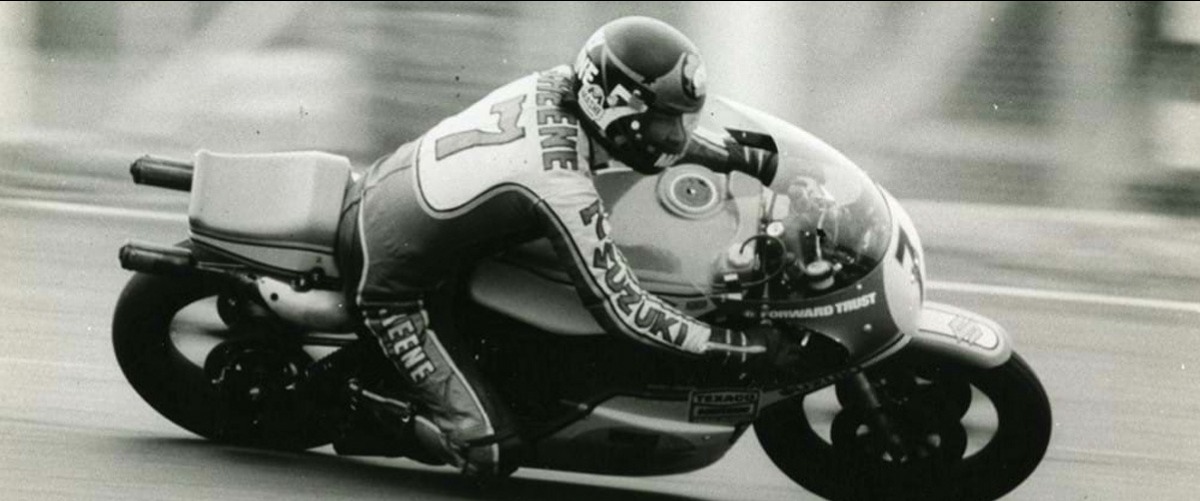
A STROKE OF GENIUS
Over 40 years ago Suzuki changed the face of 500cc GP racing with the release of the two-stroke square four XR14. This, and subsequently the legendary customer RG500 went on to win seven consecutive 500GP championships, four rider world titles, and allowed privateers to compete for GP glory on an equal footing with factory teams for the first time. One of the men responsible for this machine was Makoto ‘Big Mac’ Suzuki who, alongside Makoto Hase, developed and built the RG500 that in 1976, with Barry Sheene onboard, delivered Suzuki its first 500GP world title.
In the early 1970s, the thought of entering 500GPs with a two-stroke motor was laughable. ‘Smokers’ were confined to the tiddler classes. However despite all this, in 1974 Suzuki went against convention and entered the championship using a 500cc two-stroke that would go on to dominate the world.
“People thought we were crazy as two-stroke engines were only used on small bikes, but that was all Suzuki knew, we didn’t build four-strokes,” remembers Makoto Suzuki. “The decision was made for us, we had no option so we looked at our small capacity bikes. We had already built square four and V4 125cc and 250cc race bikes, so we upsized them. We started the project in 1973 with the target of being ready for the 1974 season and only had four people were working on it – two for the engine and two for the chassis.”
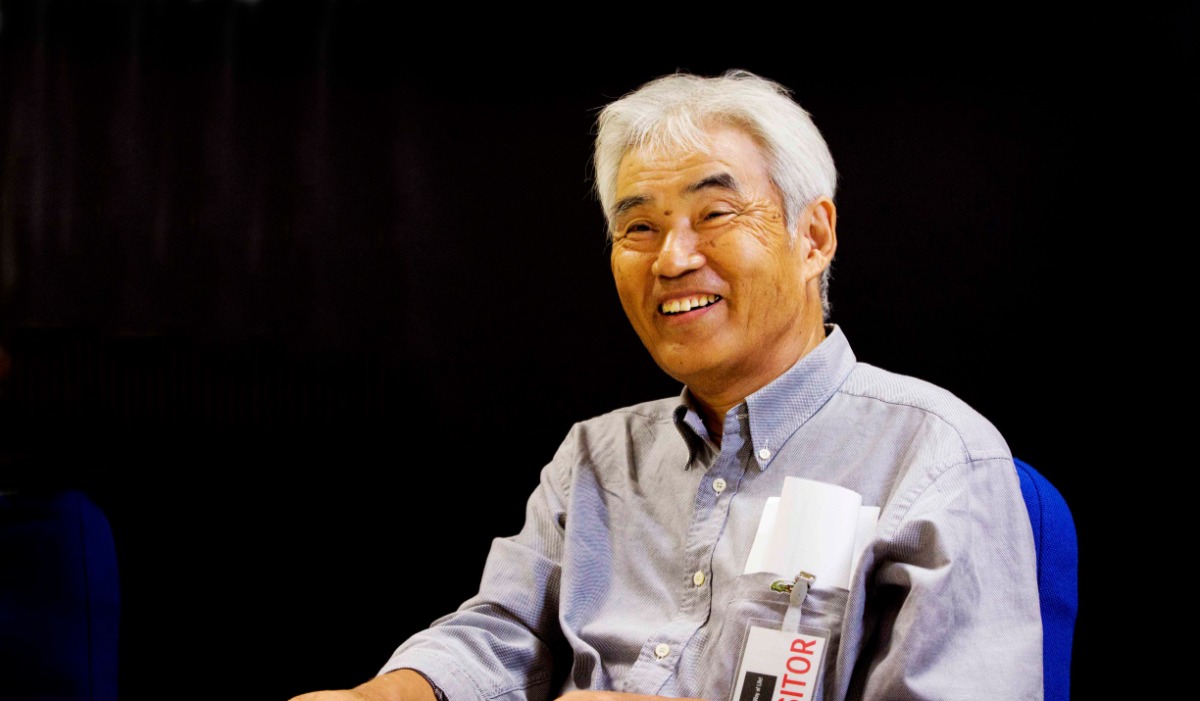
Although nowadays GP racing has reverted to four-stroke, the bike that Suzuki built demonstrated that two-strokes are very good at producing power. While this was good news for the engine’s development team, the chassis engineers were faced with some tough challenges.
“With the bike we aimed for over 100bhp, but it made 110bhp in the end,” said Makoto Suzuki, “which would have been an issue for the chassis had we not been racing the XR11 in America. The XR11 was a 750cc triple with lots of power so we had all the chassis issues with this bike. In America we suffered torn tyres, snapped drive chains, overwhelmed suspension, it was terrible, the chassis development was so far behind the engine.
“For the RG500 we used the knowledge from the XR11 to build a good chassis, however the engine was very hard to ride and peaky. The power was produced from 8,000 – 10,500rpm, that was it, but the GP mechanics at the circuit could alter these characteristics with exhausts and jets at the circuits. At that time there was a lot of experimentation and development happening, we were looking for inspiration from everywhere, even household items.
“The original exhaust end cans on the RG500 were modified green tea cans, they looked the correct size so I introduced this technology into the GP bike.”
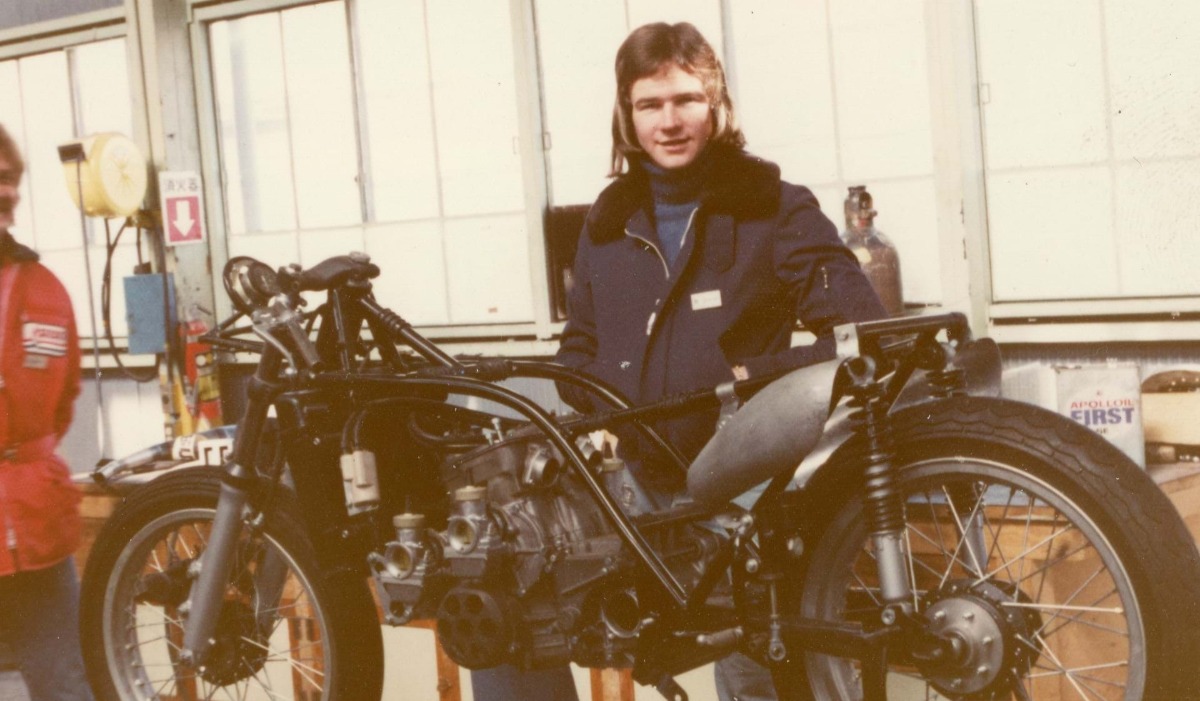
Success was quick to arrive for the RG500 and in its debut year Barry Sheene rode the XR14 to its, and Suzuki’s, first 500GP win at the Assen. Two years later he brought Suzuki its first 500GP world title, however for the RG’s development team, it was the constructor’s title that came alongside the rider’s title that meant the most.
“For Suzuki the most important thing was the constructor’s championship, not the rider’s one. If your rider wins you can only say the rider is a world champion, if you win the constructor’s championship you can say ‘Suzuki is world champion’. This drove Barry mad, he would get very upset because the privateer bikes were identical to the factory ones! For Suzuki it was excellent, we won seven constructor’s championships in a row,” laughs Makoto Suzuki.
With the RG500 Suzuki made a radical decision – they would release a privateer bike at a cost of £12,000 each that were identical in specification to the factory machines. With a grid full of RGs, the constructor’s title was all but assured.
“The only difference was the fact the factory bikes had titanium or magnesium fasteners where the production bike had steel or aluminium ones. The engine was 100% identical, we just changed the name from prototype to production. You could buy a production RG500 and win a GP, as Jack Middleburg did in 1981. That was the last time a privateer won a 500GP, however he rode an RG500 Mk VIII based on the XR22. You can imagine Barry Sheene’s frustrations.”
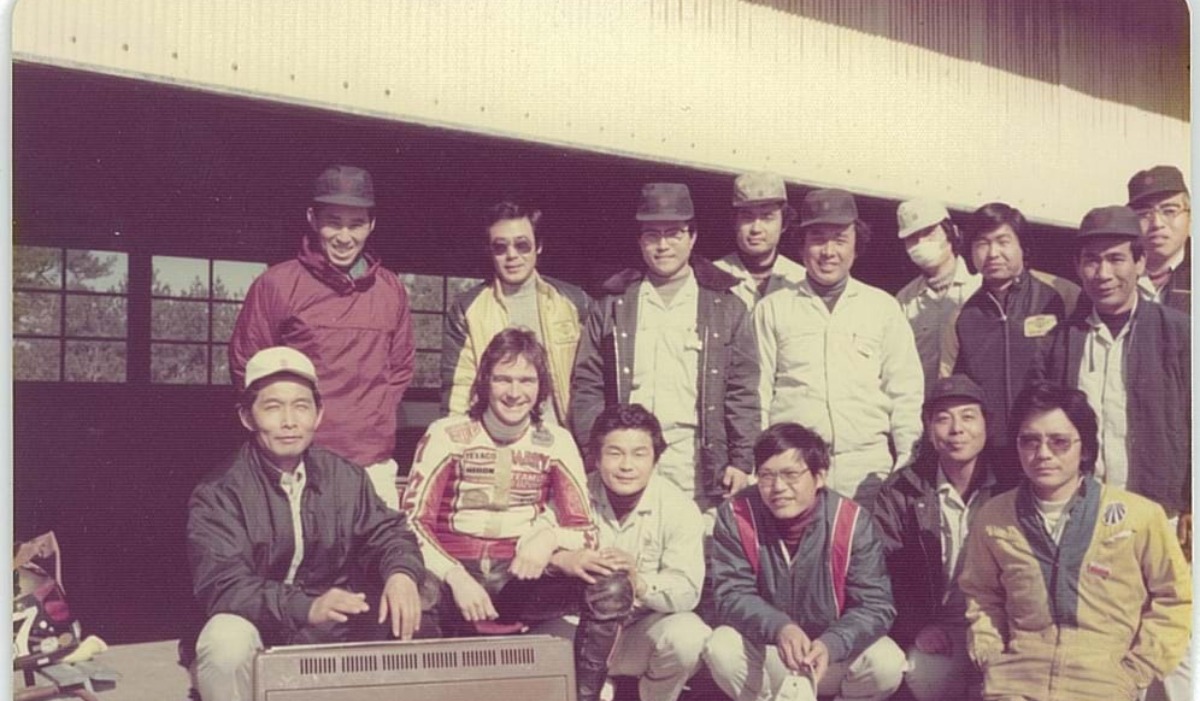
With the 1976 and 1977 titles in the bag thanks to Barry Sheene, 1978 saw Suzuki face tough competition, and upgraded the XR14 to the XR22 with its ‘step motor’. This engine used the first ‘cassette gearbox’ on a motorcycle, a feature that is common to most engine designs nowadays but was radical technology in 1978, designed following input from the McLaren F1 racing team. However, it was developed back in 1976, but it didn’t see the light of day until 1978.
“Barry won the 1976 title on the XR14 but we held the XR22 back in 1977 in case other manufacturers came out with something special,” explains Makoto Suzuki. “Yamaha in particular were a concern, but only unveiled exhaust valves and so we kept it hidden until 1978. Also, our customer RG500 was proving very popular and we didn’t want to detract from it, although we also needed to beat it as privateer riders were starting to challenge the factory ones.
“People had developed their XR14s so well they were incredibly fast and more than capable of matching the XR22. The power was not so different with the XR22 when compared to the XR14, they both made around 124bhp, however the engine was lighter which made the bikes handle better. Weight was a big factor in GPs in the 1970s and 1980s as despite there being a minimum weight of 100kg the bikes would never match this, the best we got was 108kg. With 124bhp and 108kg, the XR22 was quite a beast!”
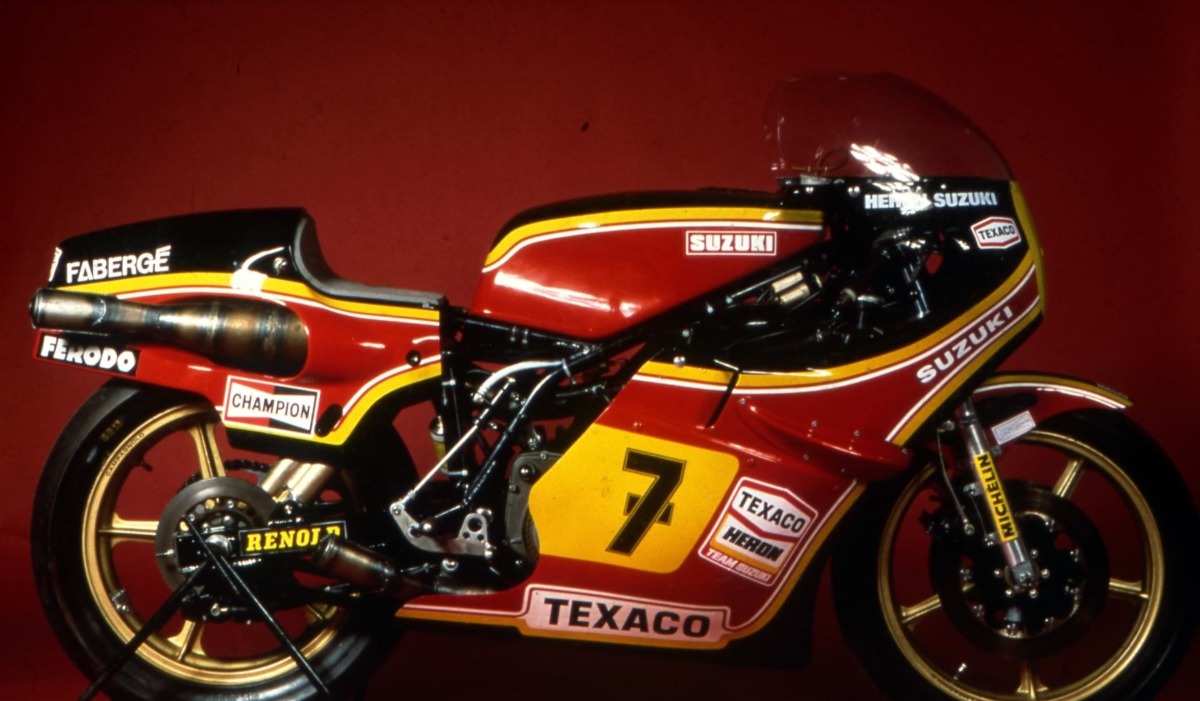
After developing the XR14 and subsequently the XR22, Makoto Suzuki was eventually able experience the power first hand.
“I rode the XR22 for half a lap in Japan and only once – that was enough for me. I pulled out of the pits and rode around a 200-degree corner and the rev counter wasn’t even registering as it started at 5,000rpm. On the straight I opened the throttle, the revs suddenly appeared, the bike wheelied and I pulled in. It was terrifying. I really appreciated the skill riders such as Barry Sheene had”
The square four design went on to dominate 500GP racing, taking two more world titles (1981 with Marco Lucchinelli and 1982 with Franco Uncini) and winning a total of 50 races alongside the seven consecutive constructor’s championships. But everything has to come to an end and in 1987 the square four RG500 was replaced by the V4 RGV500, something that was inevitable due to the fact the competition were all now using two-stroke motors.
“The square four had very good weight distribution and a lot of power. It is a simple engine but one that was reliable and worked very well, however it was limited in its power output, which is why it was replaced by the V4,” explains Makoto Suzuki. “The inlet port was limited in space, however on a V4 it is not. The more fuel and air you can get into an engine the more power you get out, which is why the introduction of the V4 boosted power from 133bhp to over 145bhp instantly.”
Suzuki GB recently restored Barry Sheene's world championship-winning XR14s to their former glory. Watch the two-part video documentary below.
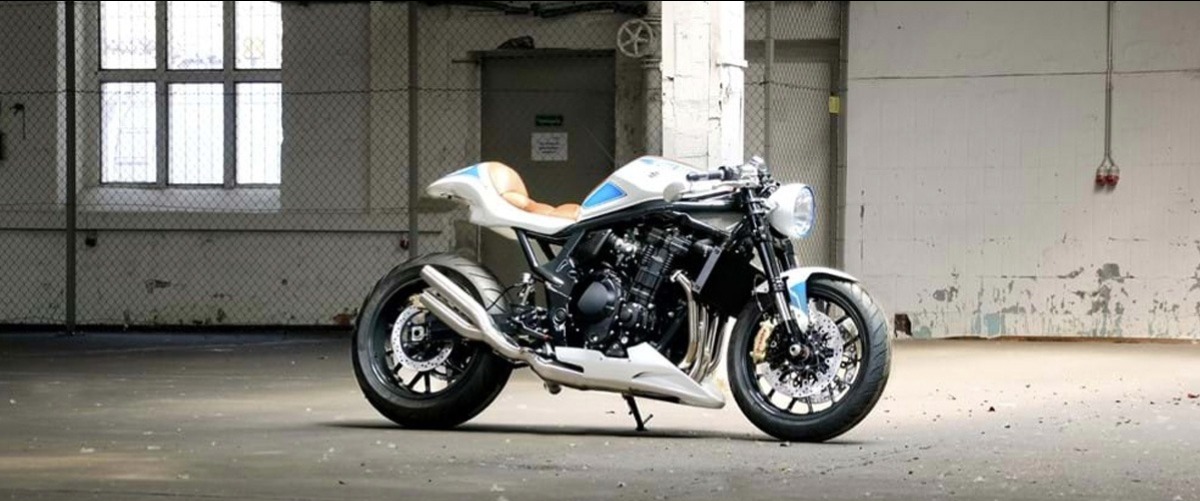
DESIGNING THE SUZUKI' FATMILE'
The Bandit 1250-based 'FatMile' was designed using what the Japanese call Senpai-Kohei, where a young designer with new and fresh ideas is brought together to work with an experienced designer who will guide and direct them. For the FatMile designer Daniel Händler teamed up with legendary Suzuki designer Hans A. Muth, architect of the iconic Suzuki Katana.
The bike was initially built for the Glemseck 101 festival in Germany; one of the biggest café racer gatherings in Europe. Since then it has done the rounds at Intermot, EICMA and Motorcycle Live.
To stay true to the Senpai-Kohei design principle, Suzuki deliberately opted to buck the obvious trend of working with a big design studio or well-known customiser, instead putting its faith in Händler to steer the project with Muth overseeing the process.
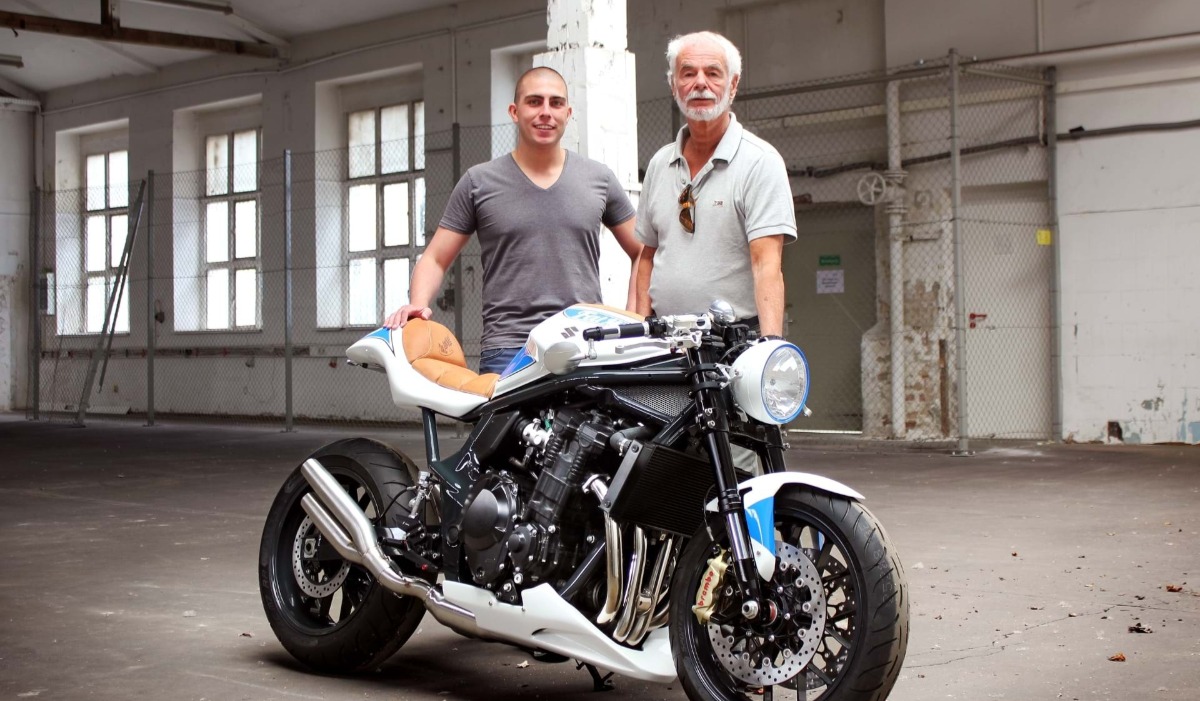
“Of course we took a certain risk with this decision,” admits Gerald Steinmann of Suzuki Europe. “When you hire an established design agency or world-famous custom builder hardly anyone will come out with criticism. But we consciously took this different approach and chose a solution in the Japanese tradition. Looking at the FatMile now I am convinced we did the right thing.”
A number of donor bikes were considered for the project, with the Bandit 1250 eventually becoming the starting point.
“We looked at a number of options,” Händler explains. “But, along with the GSX-R, the Bandit series is an iconic series for Suzuki, so this is why we chose it.”
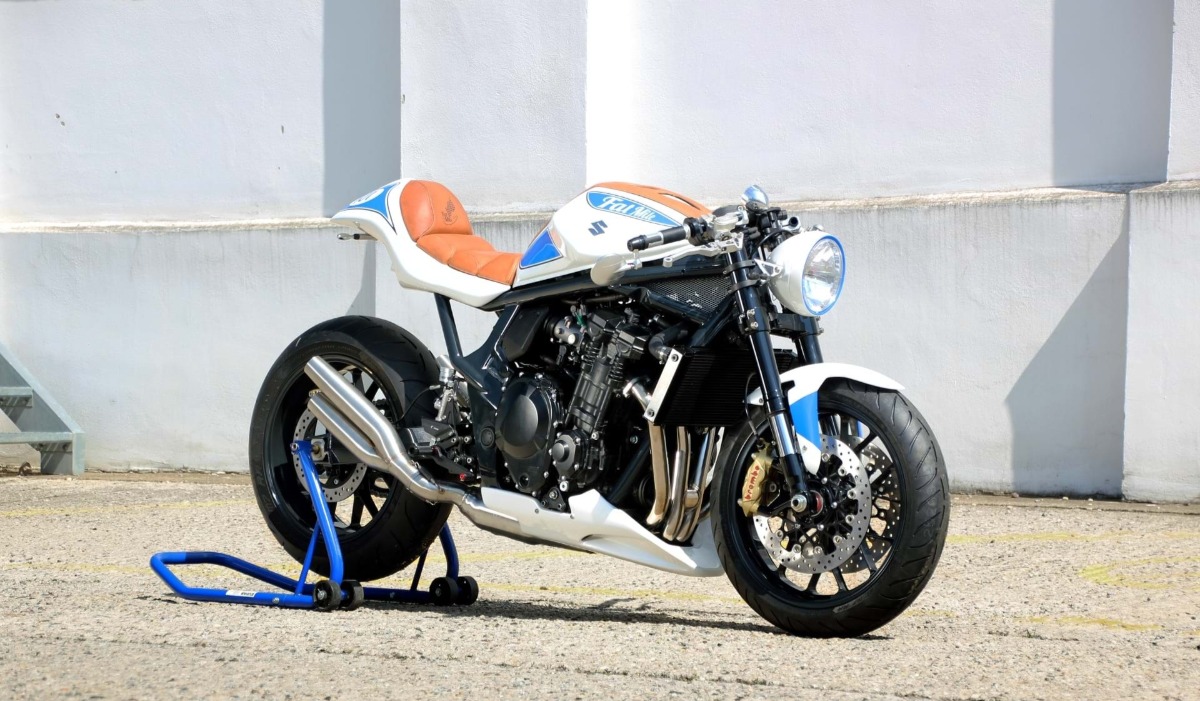
With Händler bringing the innovation and fresh approach, responsibility fell to Muth to guide him on his ideas, designs, concepts and finally implementation when it came to building the FatMile. Muth also had an eye on preserving the Suzuki design identity.
Händler continued, “In this project Mr. Muth was an extremely good tutor for me. At the beginning of our cooperation we shut ourselves away for three days to only talk and outline the FatMile project. That was enormously motivating and instructive for me.”
Muth added, “Mr. Händler is full of good thoughts and ideas. Sometimes I had to remind him to consider the limits of real implementation at early draft stages, but we worked in good harmony. I think that together we have created a very good machine.”

The Suzuki FatMile uses the 1255cc motor from the Bandit mated to custom Cobra Urban Killer exhausts. Swingarm is standard Bandit but the frame has a modified rear subframe and seat unit with a custom seat to go with the new Paaschburg & Wunderlich headlight, GFK front fender and custom paint scheme.
Front forks are 2012-2016 GSX-R1000 which, at 5cm shorter than Bandit forks lower the front end of the bike. Front brake calipers are Brembo monobloc from the same GSX-R1000 with GSX-R discs too. Rear stopping power comes from a four-pot Nissin caliper and B-King disc. The bike is fitted with Spiegler brake lines.
Tacho is a tiny Motogadget Motoscope and PVM wheels don Metzeler Sportec tyres. Rearsets are Rizoma RRC, handlebars are Rizoma Lux, and mirrors are Rizoma Spy-R 80.
Photography:Sven Wedemeyer

SUZUKI OFFERS SUMMER TEST RIDE INCENTIVE WITH £500 CUSTOMER SAVING
Suzuki has launched a new summer incentive, rewarding anyone that takes a test ride on selected models with £500 off the RRP when they go on to purchase. The offer runs in conjunction with all current campaigns, and across most of Suzuki’s on-road range.
Running from 1 August to 9 September, the incentive applies to both the GSX-R1000 and range-topping GSX-R1000R, the GSX-S1000F, GSX-S1000, and GSX-S750, both variants of the V-Strom 650 and V-Strom 1000, plus the SV650X and the new-for-2019 KATANA.
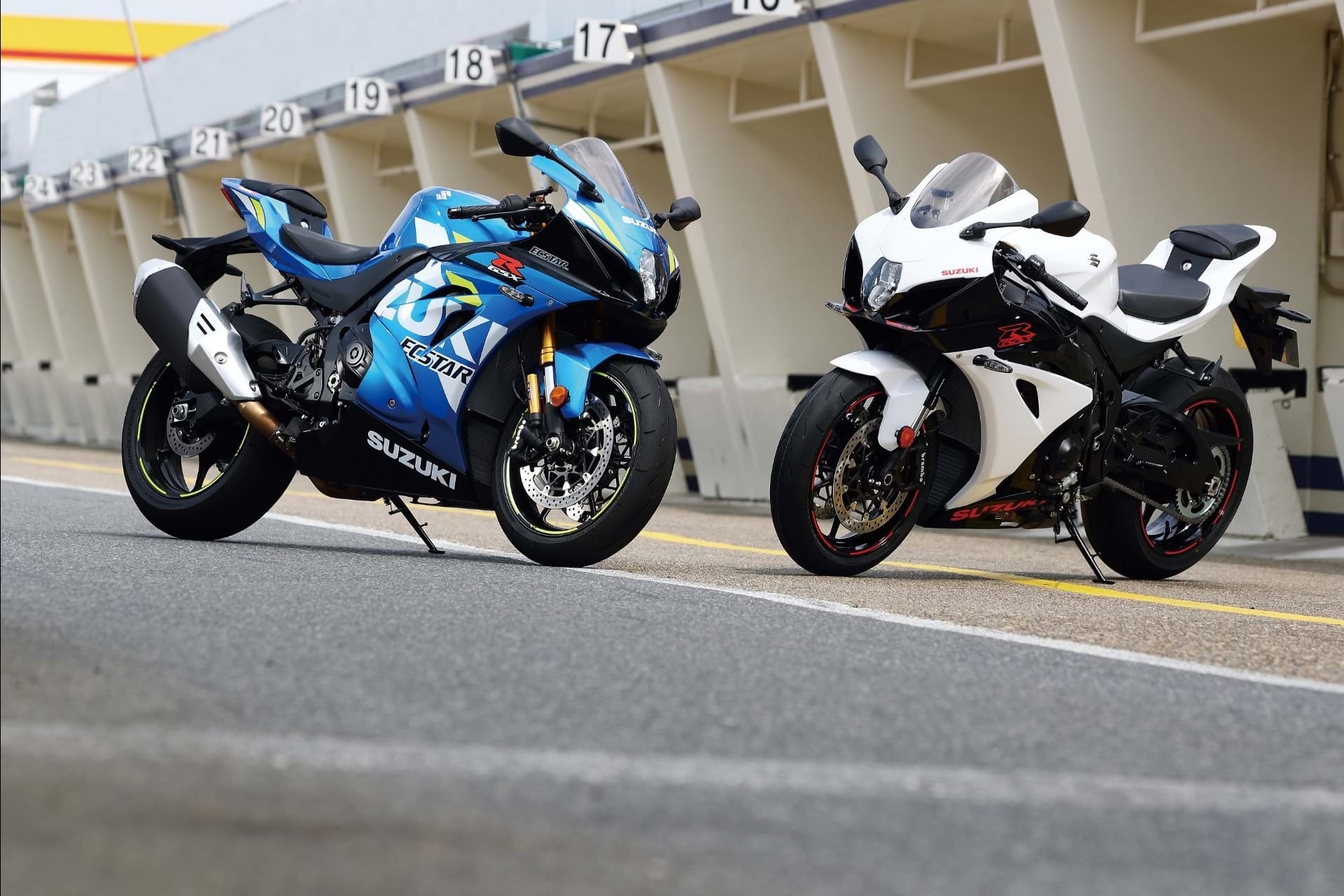
The offer also runs alongside the current HP and PCP promotions. This includes both the 0% APR finance offer on the GSX-R1000R, as well as Suzuki’s low rate finance campaign, which allows customers to choose from 2, 3 or 4 years with an APR to match.
Finally if choosing a V-Strom, customers will also benefit from £500 worth of free accessories, making Suzuki’s adventure range a truly tempting proposition.
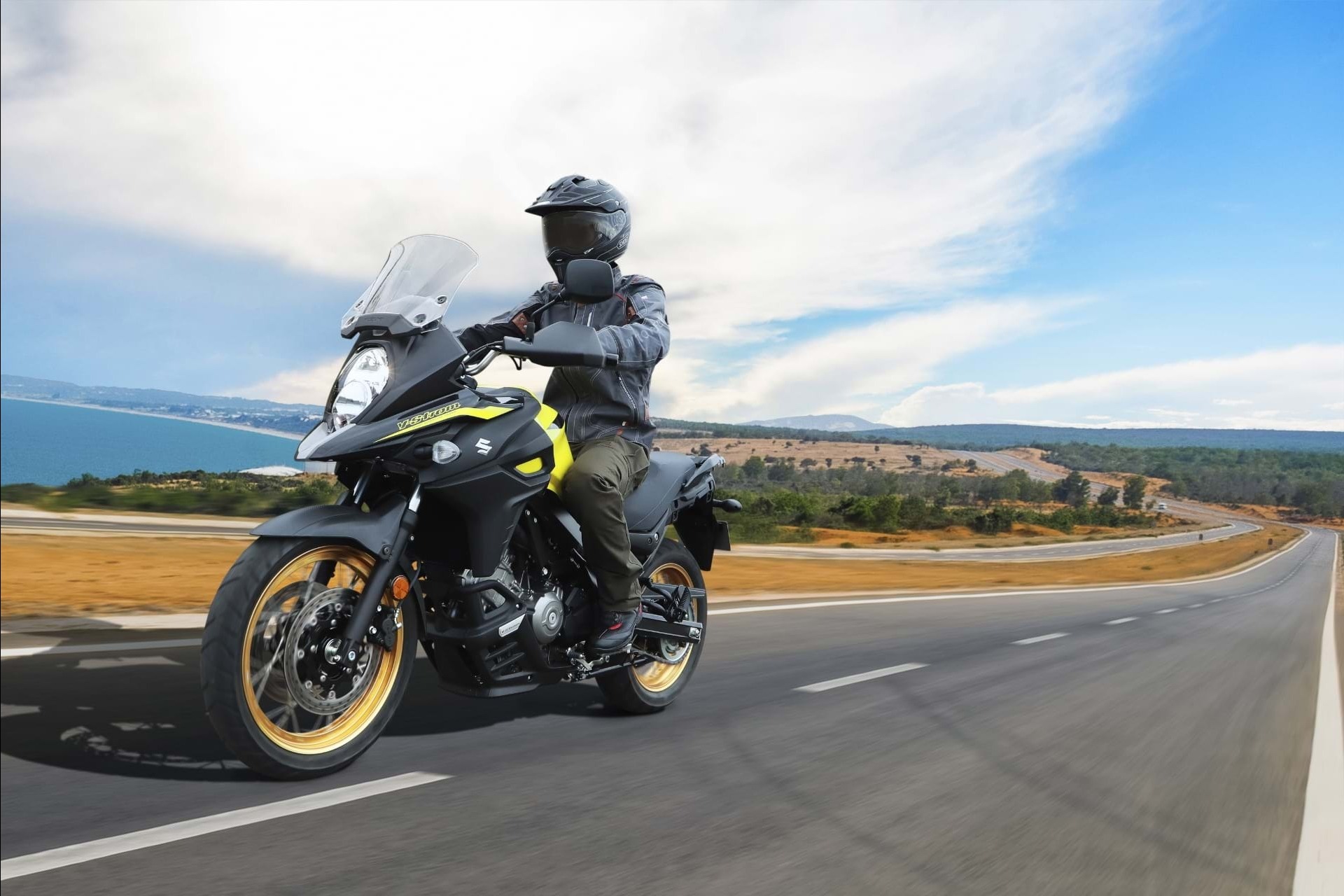
Suzuki GB head of motorcycles, Jonathan Martin, commented, “Summer’s in full swing, but for those still in the process of selecting a new bike for the season, this offer is an added sweetener alongside our current offers, that makes riding a new Suzuki this summer a tempting and viable option”
0% APR finance available on 2018 models of GSX-R1000R/RZ. Low rate finance available on GSX-S1000F, GSX-S1000, GSX-S750, Vstrom 650 & V-Strom 1000. Minimum Deposit £1,000. Credit is available to UK residents aged 18 and over, subject to status. Suzuki Finance is a trading style of Suzuki Financial Services Limited; St William House, Tresillian Terrace, Cardiff, CF10 5BH.
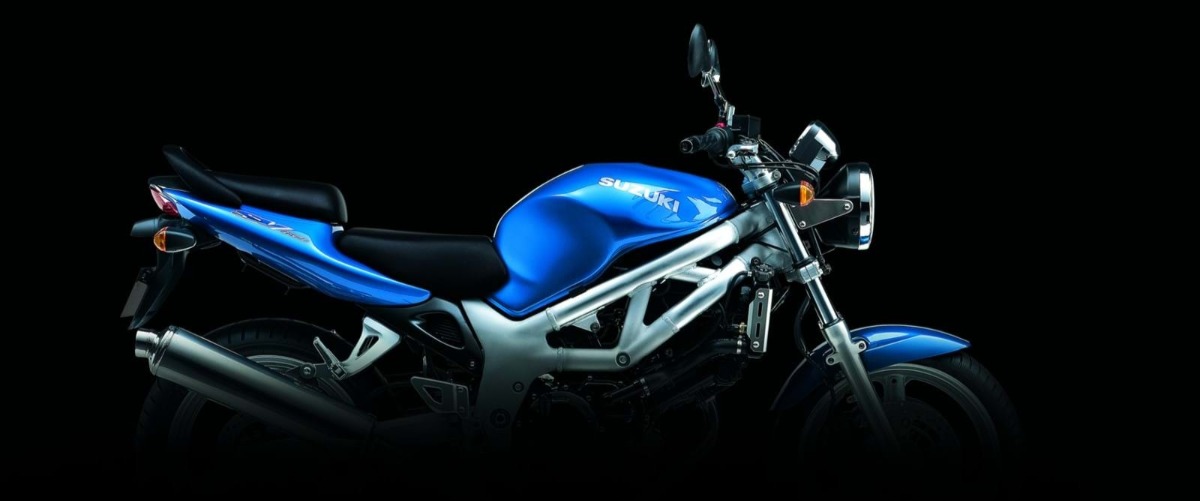
The story of the SV650
The SV650 was first introduced in 1999 as an affordable-but-fun middleweight, available either naked or half-faired. No one, not even Suzuki, could have imagined the cult appeal the bike would develop, as it appealed to everyone from commuters to riders looking for a capable tool for a weekend blast, and now fills race grids up and down the country. 20 years on, we take a look back at the history of one of the biggest overachievers in motorcycling.
The naked version of the SV650 cost just £3,999 when it was launched back in 1999, with the S model a mere £300 more. Both bikes immediately found favour with the motorcycling public, with a combined 2,549 sold in the first year and 2,939 the following year.
The SV was designed to be the answer to many people’s prayers; a robust, reliable, but characterful V-twin middleweight, suited to a range of riders and uses.

It was affordable and did everything it needed to. But it did it better than its rivals, with nimble, agile handling more akin to more expensive, sportier machines, and an engine that has gone down in motorcycle folklore. MCN referred to it as a ‘straightforward middleweight V-twin all-rounder which proves you don’t have to be boring to be practical’. It found a niche and it excelled.
It was comfortable as well, with a plush seat and easy-going ergonomics – especially the naked version. It could take a pillion too. And there was a great range of accessories, which meant the SV could be taken touring across the continent, or, with the fitment of fairing lowers, a pillion seat cowl, and a racy exhaust, become a mini V-twin weapon between the hedges.
Such a weapon in fact, that in club racing, the SV650 was the bike to be on when it came to the twin classes. As people sought more affordable ways of going racing, the SV filled Minitwin grids up and down the country, which boasted tighter regulations than other classes of racing. Frames couldn’t be modified, nothing could be done to the engine, and even things like the forks had to remain standard. However, the basic package from Hamamatsu was far greater than the sum of its parts, and the bikes posted impressive lap times around circuits like Donington Park, Brands Hatch, and Cadwell Park.
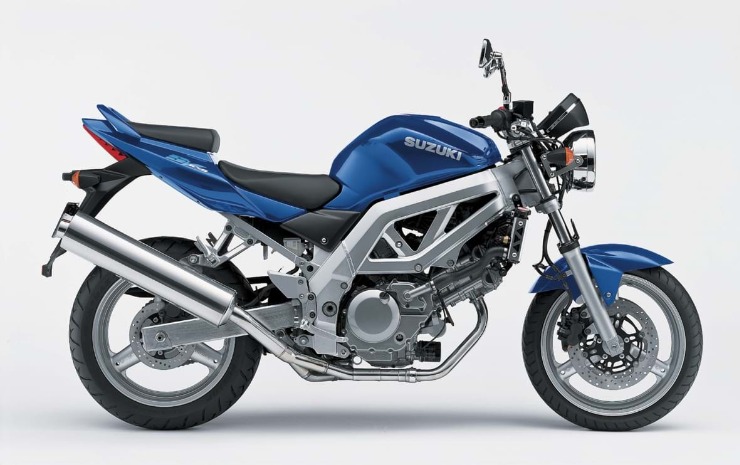
2003 saw the introduction of the second generation SV650. The new bike boasted an all-new cast aluminium frame, new swingarm and new exhaust. It also made the switch to fuel injection from carburettors. It got a power hike, too, taking peak power up to over 73bhp, while peak torque increased to 47.2lb-ft.
And it continued to fly out of the showrooms too. 2,266 were sold when the new bikes were introduced, as new riders, commuters, and racers alike sought them out.

In 2007 new twin-plug heads were introduced to improve emissions, but it was the last update before the naked SV650 was superseded by the SFV650, which was launched in 2009.
The SFV650 was launched in Fuerteventura to widespread praise. MCN rated the upgraded engine five out of five, and commended the new bike, writing “the old SV650 was a good bike and to be honest Suzuki didn’t have to do much to make it a great bike once more. But they have gone one better and given us an excellent bike.”
Changes to the camshaft profiles and valve lift, a 10% increase in crankshaft inertia, newly staggered intake and exhaust tract lengths, and a new exhaust made it possible to boost low-rpm and midrange power, without sacrificing top-end output. There were also new valve springs, and while the bore and stroke remained the same from the older SV650, the bore was plated with Suzuki’s race-proven nickel-phosphorus-silicon-carbide coating. It also benefited from new iridium spark plugs.
The most striking difference was how the new bike differed visually from the SV. The classic styling made way for more modern lines, and a new steel trellis frame replaced the aluminium frame of the outgoing SV650.
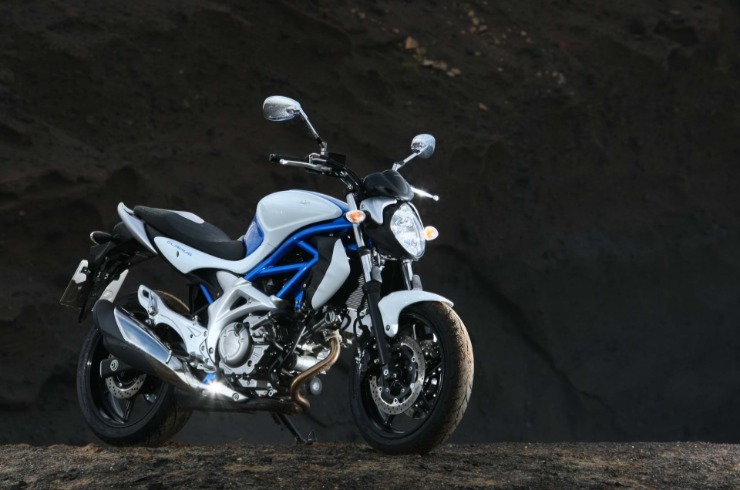
In classes where limited modifications were permitted, the SV650S continued its dominance of club racing grids, with it’s clip-ons and removable rear subframe. But in the more relaxed Supertwin classes, the SFV650 was carving a name for itself.
JHS Racing in particular were championing the way with the SFV, turning out an exquisite example dressed in GSX-R600 fairings, that turned heads when on display at Motorcycle Live.
The preparation put into the bike was essentially the same that goes into a superbike. The JHS SFVs used the original crankshaft, but got new con-rods, pistons, valves and valve springs. It retained the standard ECU, but with some parameters changed and some sensor eliminators, to extract every ounce of power. This bike didn’t have to do thousands of miles between services.
“The SFV650 boasts even more potential than the SV for racing,” James Holland from JHS Racing said at the time. “It’s the engine we like the most, as the nickel-phosphorus-silicon-carbide coating in the bores allows us to run higher tolerances with our pistons and rings.”
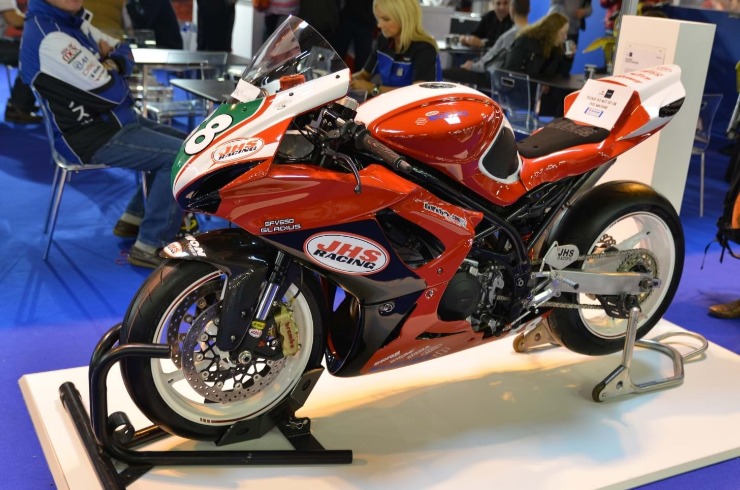
But for 2016 the naked SV returned to the range, doing everything it did in 1999, only better. It’s more powerful and lighter than the SFV650, with clean, classic styling to appeal to a variety of riders. It boasts some more tech too, with a one-push, easy-start system and Suzuki’s low-rpm assist function that makes it incredibly difficult to stall the bike when pulling away. On its launch in northern Spain it was praised for its handling, with Bike Social writing, “The Suzuki’s chassis is mint. It turns well, holds a line, and leans over till the long hero blobs and exhaust are dragging if you want.”
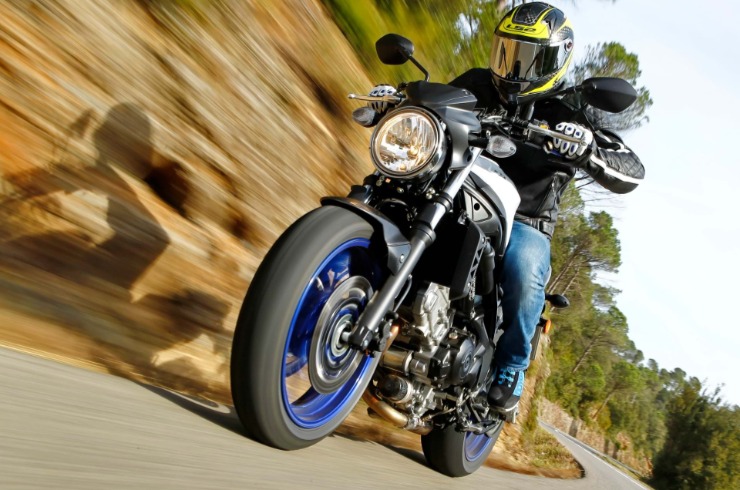
Two years later and the SV650X joined the lineup alongside the standard SV, while the S made way. It offered something new for SV customers, sporting café racer-inspired styling with a bikini fairing, dropped bars, and ribbed seat, plus a retro-style livery.
The SV650 remains a model that does far more than it should, better than it should. When the first SV650 rolled off the production line in the late 90s, no one would have believed that it would find favour with so many riders looking for so many different things, and go on to fill club racing grids and tackle the Isle of Man TT. It really is one of motorcycling’s biggest overachievers.

SUZUKI ANNOUNCES ITS SUMMER LOW-RATE FINANCE OFFER
Suzuki has announced the details of its summer low rate finance offer, which gives customers the ability to tailor a finance package to their individual needs by choosing from either a Personal Contract Purchase (PCP) or Hire Purchase (HP) agreement, and the term of their choice – from two, three, and four years – with an APR to match.
The offer is available on all V-Strom 650 and V-Strom 1000 models, plus the GSX-S1000F, GSX-S1000, and GSX-S750 street machines, with a minimum deposit of £1,000. With a minimum deposit of £500 customers can also take advantage of the offer on the GSX-S125 and Address scooter.
Address HP Only. Credit is available to UK residents aged 18 and over, subject to status. Suzuki Finance is a trading style of Suzuki Financial Services Limited; St William House, Tresillian Terrace, Cardiff, CF10 5BH.
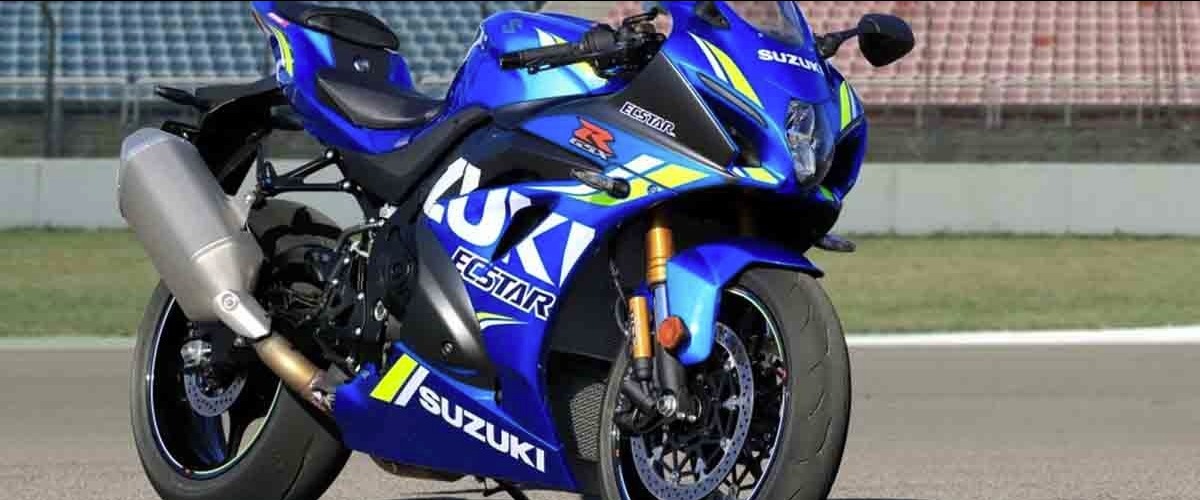
SUZUKI ENHANCES GSX-R 0%REPRESENTATIVE FINANCE OFFER
Suzuki has announced an enhanced 0% APR Representative finance offer on the award-winning and race-proven GSX-R1000R plus the entry-level GSX-R125, available until the end of September 2019. There’s also a new £250 Suzuki deposit contribution on the GSX-R125.
Available with a minimum deposit of £1,000 on the range-topping GSX-R1000R, customers can ensure they’re choosing a deal that best suits their personal circumstances, and opt for either a Personal Contract Purchase (PCP) or Hire Purchase (HP) agreement.

Suzuki’s 0% APR Representative offer also extends to the learner-friendly GSX-R125, which is available with a minimum deposit of £750, £250 of which comes as a Suzuki deposit contribution, meaning buyers need only £500 deposit.
The GSX-R1000R uses a host of MotoGP-derived technology, from a clever variable valve timing system that allows it to produce both low-down and midrange torque and impressive top-end power, to a comprehensive suite of performance-boosting electronics that includes an IMU-governed, 10-mode traction control system, launch control, quickshifter and auto-blipper, and cornering ABS.
The GSX-R125 set new benchmarks when it was launched in 2017, coming into the 125 sports bike market with the best power-to-weight ratio. It boasts an LCD dash, LED lighting, keyless ignition, and Suzuki’s easy-start system.
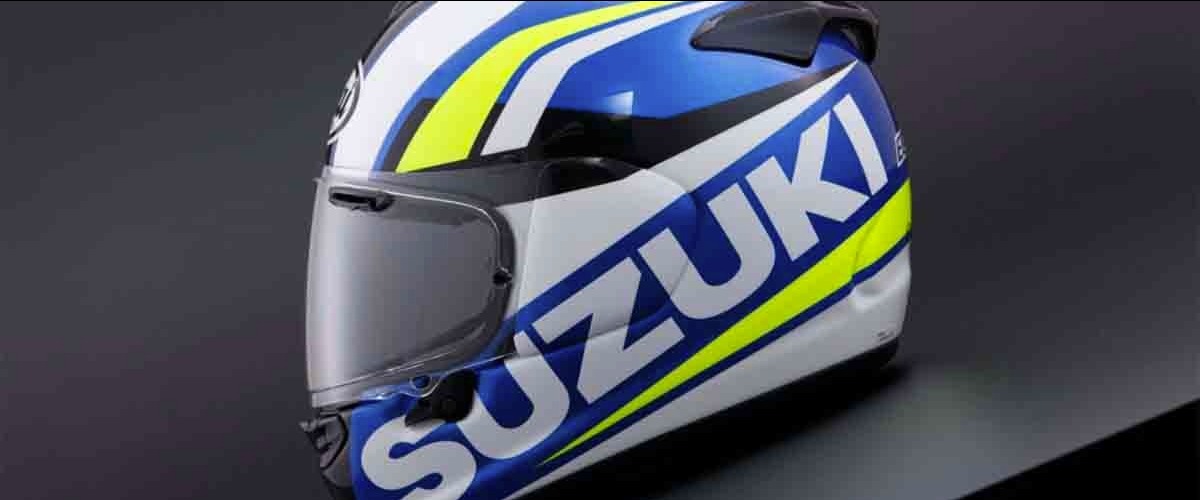
SUZUKI MOTOGP-INSPIREDARAI CHASER-X AVAILABLE
Suzuki and Arai have joined forces to create a Team Suzuki Ecstar, MotoGP-inspired Chaser-X limited edition helmet, which comes with an RRP of £550 and is available now through authorised Suzuki dealerships or online.

The helmet gets a striking blue, white, and yellow design with bold Suzuki lettering, reminiscent of the firm’s GSX-RR MotoGP racer, and is ACU Gold Standard certified. It also uses a double d-ring chin strap fastener, Arai’s new shield latch system, and includes liner speaker pockets.

SUZUKI SET FOR INAUGURAL ADVENTURE BIKE RIDER FESTIVAL
Suzuki will showcase its adventure and off-road ranges at the inaugural Adventure Bike Rider Festival, which takes place from 12-14 July at the Ragley Hall Estate in Warwickshire, with visitors also able to enjoy test rides on many of the models on display.
The range-topping V-Strom 1000XT – which features a 1037cc V-twin engine packed with low-down torque and a broad midrange, plus a two-mode traction control system and intelligent cornering ABS – will be displayed alongside the standard V-Strom 1000. The cult-favourite V-Strom 650 will also be on display, side-by-side with the more off-road-focussed V-Strom 650XT, which swaps cast wheels for lightweight spoked options, and gets hand guards and lower cowling as standard. Both models use Suzuki’s characterful and famed 645cc V-twin engine, and get traction control and low RPM assist.

Demonstrating the V-Strom’s adventure-potential is the Bike to Japan V-Strom 1000, which was ridden from the UK all the way back to the Suzuki factory in Hamamatsu, Japan in 2014.
Proving big adventures can come in small packages is the V-Strom 250. The A2 licence-friendly machine uses a flexible parallel twin engine, and includes full luggage among its range of accessories, and will be on display along with its larger capacity siblings.
Further highlighting the Japanese brand’s off-road prowess is the RM-Z450 motocross machine and KingQuad 750 ATV, both of which will be present on the Suzuki stand, while the head-turning new KATANA will nod to the firm’s street bike range.
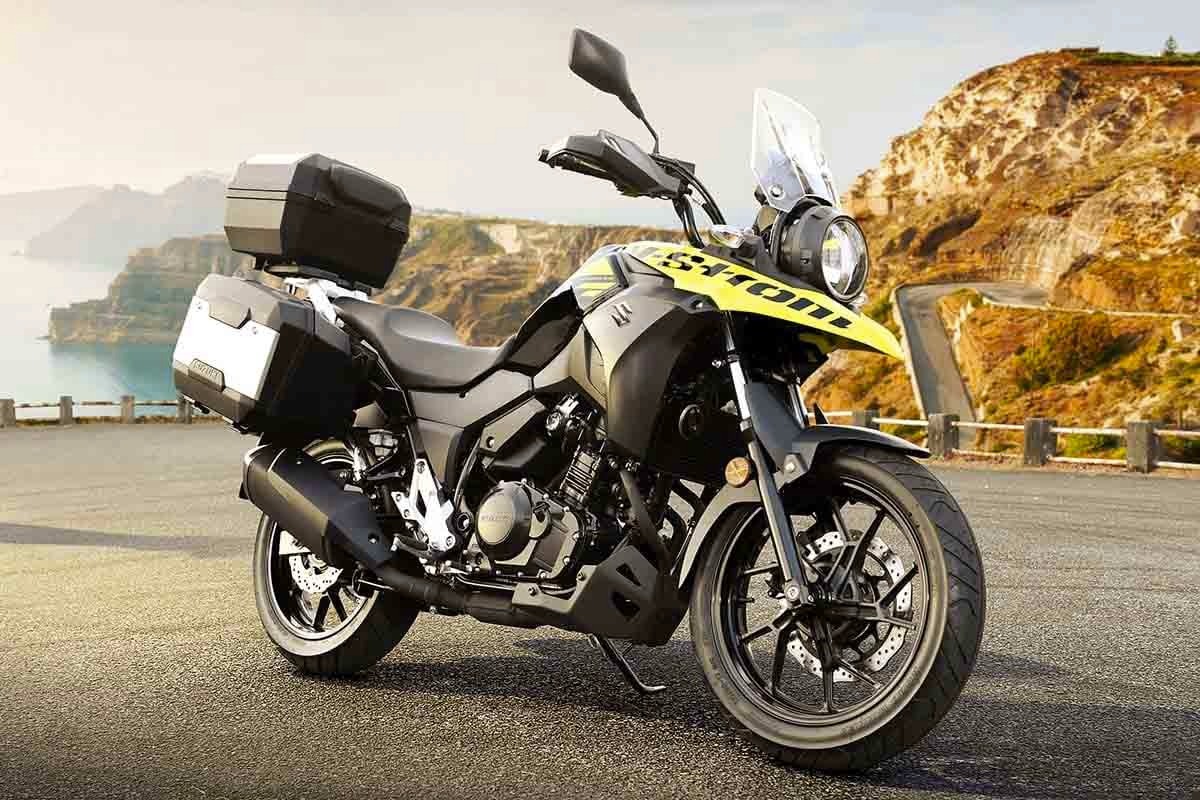
Visitors to the festival can also sample the entire V-Strom range for themselves, with test rides available over the course of the event. The KATANA – an evolution of the iconic 1981 machine that uses a 150hp version of the legendary GSX-R1000 K5 engine, housed in a lightweight aluminium chassis and tamed with a three-mode traction control system – will also be available for demo rides.
For more information on Suzuki’s adventure range, click here. To find out more about the new KATANA, click here.
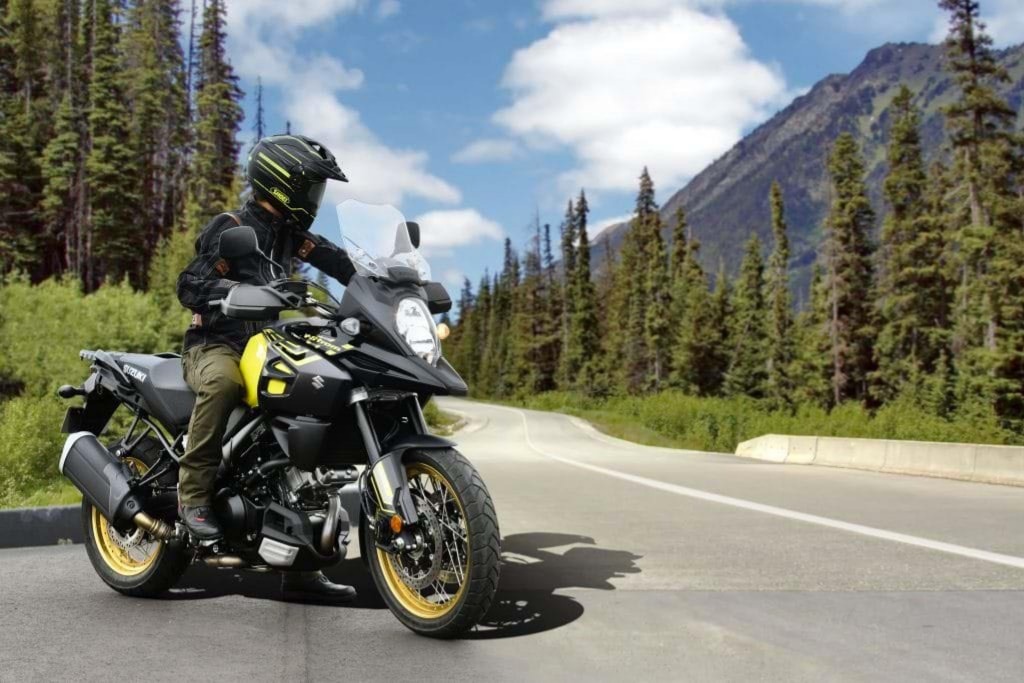
SUZUKI REVAMPS SPRING OFFER
Suzuki’s widely-regarded finance offer – which gives customers the ability to choose either a two, three, or four year agreement with an APR to match, plus the option of deciding between a PCP or Hire Purchase deal – will continue this spring, with new models now included in the campaign. Both the V-Strom 650 and V-Strom 1000, plus the XT and GT variants of both models, are now available as part of the offer. The award-winning V-Strom 650 uses Suzuki’s famed 645cc V-twin engine and features a two-stage traction control system (which can be turned off), plus easy-start and low rpm assist. Meanwhile the range-topping V-Strom 1000X GT comes fully-equipped with aluminium top box and panniers, plus tapered handlebar and lightweight spoke wheels.
The SV650X – the café racer-inspired version of the equally-popular SV650 – is now part of the offer, along with the GSX-S1000 and GSX-S1000F, GSX-S750 and learner-friendly GSX-S125, plus the Address scooter.
All new models from Suzuki come with a three-year warranty and one-year Suzuki Roadside Assistance. Each is also equipped with Datatag’s MASTER security system for added peace of mind.
For information on all of Suzuki’s offers, click here.
Minimum deposit £300. Address Hire Purchase finance only. Credit is available to UK residents aged 18 and over, subject to status. Suzuki Financial Services Limited, St William House, Tresillian Terrace, Cardiff, CF10 5BH.
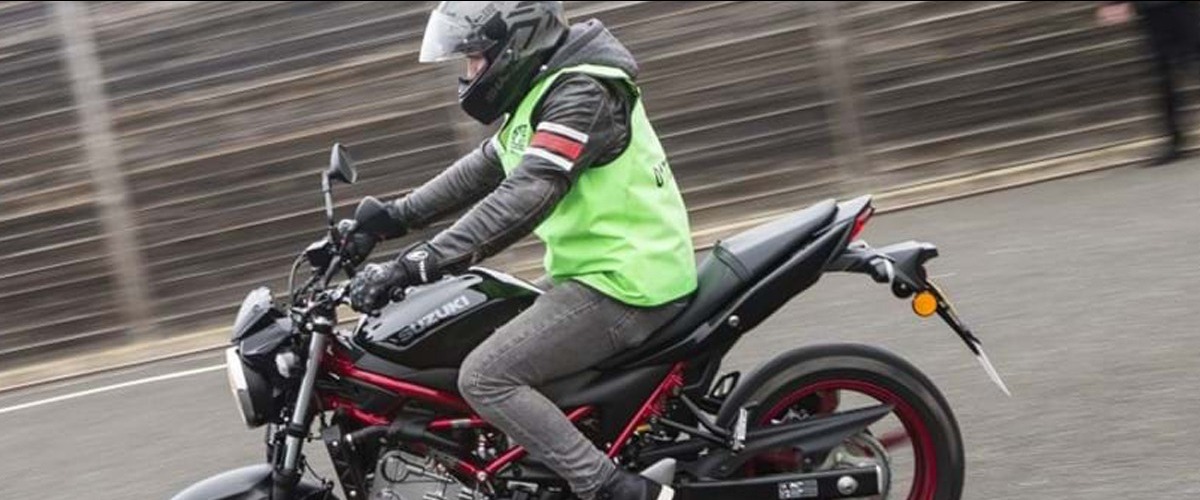
TEAM GB BMX STAR DECLAN BROOKS PASSES MOTORCYCLE TEST
Team GB athlete, freestyle BMX star, and Olympic hopeful Declan Brooks has swapped pedal power for horsepower, passing his motorcycle test using Suzuki’s SV650.
Brooks – who finished third in the FISE Chengdu BMX World Cup event in China last November – passed his CBT last year, as he took the first steps into gaining his motorcycle licence. Now, with nearly a year’s worth of experience under his belt, the 21-year-old has passed both his module one and module two assessments, thanks to Shires Motorcycle Training, and can finally remove the L-plates as spring arrives.
Declan Brooks, “I’m used to feeling nervous ahead of world championship competition, but it didn’t stop the apprehension for each part of the test, so it was a huge relief to be told I’d passed. I really enjoyed learning, doing my CBT, and getting some miles in on the GSX-S125 last year, but I was keen to keep going and go through my full test. I definitely enjoyed having more power on tap and a bigger bike with the SV, too. This has come at the perfect time as well; it’ll not be long until the clocks change and the weather warms up, and I’m now excited to get on the road and plan some rides this coming summer.”
Brooks is currently competing in world championship around the globe, with the aim of representing Team GB at the Tokyo 2020 Olympics, the first time freestyle BMX will be included in the games. He is also from a motorcycling family and background, his father racing before Declan got his first taste of a motocross bike at four.
He added, “I think having a bicycle and two-wheeled background definitely helped. Even though there are obviously massive differences, you’ve got a feel for balance, how to use your weight, things like that. My dad will be pleased too!”
Riding a GSX-S125 to pass his CBT and gain experience, Brooks will now use Suzuki’s user-friendly SV650. However, due to his age, the 74bhp machine uses a restricted ECU to bring it down to the 47bhp limit, available through authorised Suzuki dealerships.
SUZUKI CONFIRMS PRICING ON NEW COMMUTER MODELS
 Suzuki has confirmed pricing for its new Address 110 and Inazuma 250F models, with the economical commuter-targeted machines priced at £1,799 and £3,999 respectively.
Suzuki has confirmed pricing for its new Address 110 and Inazuma 250F models, with the economical commuter-targeted machines priced at £1,799 and £3,999 respectively.
The Address 110 defines urban practicality, with its impressive 145MPG* figure, a kerb mass of just 97kg, and over 20 litres of under-seat storage. The stylish new scooter also boasts cutaway footboards, making it easy to stop around town, a rear brake locking system for use when parked, and an ignition cover which aids in security.
Performance comes from a new fuel injection system and redesigned piston skirts, while cast aluminium wheels with hollow cores boost handling capabilities.
The new scooter comes with an RRP of £1,799 while a number of optional accessories are also available, including a top box, hand guards, and tall windscreen.
The Inazuma 250F joins Suzuki´s on-road range for 2015, following the success of the naked Inazuma 250 launched at Motorcycle Live 2012.
The new F variant adds a fairing and screen for improved weather protection on longer journeys, all wrapped around an economical 248cc parallel twin capable of 85MPG* while also delivering enough punch for a spirited ride out of town.
The Inazuma 250F is available with an RRP of £3,999. Both the Address 110 and Inazuma 250F are expected in dealers in March.
*Data resulting from tests made by Suzuki in compliance with WMTC. These tests were conducted by a single pilot with no additional optional equipment. Fuel consumption may vary depending on your riding style, how you maintain your vehicle, weather, road conditions, tyre pressure, the presence of accessories, the load, the weight of the crew and many other parameters
SUZUKI V-STROM 650XT NOW IN DEALERS
 Suzuki´s new V-Strom 650XT is now available in dealerships nationwide, with pricing confirmed at £7,499.
Suzuki´s new V-Strom 650XT is now available in dealerships nationwide, with pricing confirmed at £7,499.
Based on the popular V-Strom 650, which has been the best-selling mid-capacity dual-purpose motorcycle over the last decade, the new XT version boasts lightweight DID wire spoke rims, designed to improve performance on unpaved roads, while a new beak takes design cues from the V-Strom 1000 and iconic DR Big and improves airflow to the radiator.
Hand guards, aluminium sump protector and engine bars complete the look and add to the V-Strom 650XT´s rugged presence.
Suzuki GB Marketing Manager Rob Cooper commented, “The XT version of the popular V-Strom 650 builds on the original bike´s proven platform as a comfortable and capable adventure-tourer, but adds new levels of practicality with the wire wheels and other added extras, helping maintain the V-Strom´s position as the best dual-purpose machine in this sector of the market.”
The V-Strom 650XT is available in authorised Suzuki dealers now with an RRP of £7,499. Additional accessories, including aluminium luggage and Vario touring screen, are also available.
WATERS AND IDDON JOIN HALSALL SUZUKI FOR 2015 BRITISH SUPERBIKE CHAMPIONSHIP
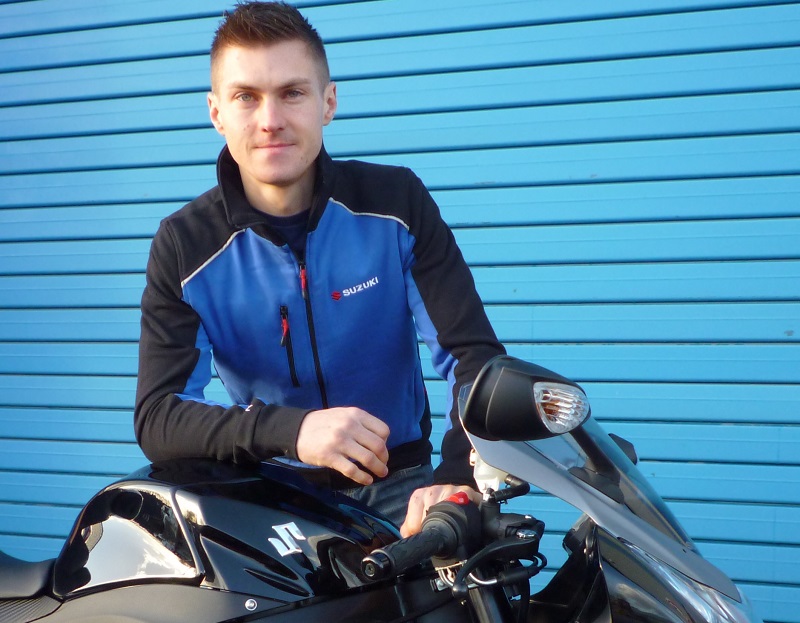 Double British Superbike race winner Josh Waters and World Superbike EVO front runner Christian Iddon will join the Halsall Racing Team in 2015, spearheading Suzuki’s official entry in the MCE Insurance British Superbike Championship.
Double British Superbike race winner Josh Waters and World Superbike EVO front runner Christian Iddon will join the Halsall Racing Team in 2015, spearheading Suzuki’s official entry in the MCE Insurance British Superbike Championship.
The move will see Waters continue his long relationship with Suzuki, having taken two Superbike titles for the Japanese marque in his native Australia between 2009 and 2012. In 2014, the 27-year-old took the Suzuki GSX-R1000 to two race victories and secured a brace of top six results.
Having spent two years racing on the world stage, Iddon will return to Britain in 2015 for what will be his first full season in the MCE British Superbike Championship. The 30-year-old is no stranger to success in the UK having taken two victories on his way to fifth place in the 2012 British Supersport Championship. The nine-time British Supermoto Champion also impressed by taking pole position in a wildcard appearance at the Assen round of British Superbikes last year.
Last month Halsall Racing announced a partnership with Suzuki GB which sees the Bolton-based outfit become Suzuki’s official British Superbike representative from the 2015 season.
Josh Waters:
“I’m excited to be back in British Superbikes for a third year in 2015. It’s great to be staying with Suzuki and I’m really looking forward to moving into the Halsall team. I really enjoyed riding a couple of rounds for Martin in 2013 and Jack Valentine has such great experience with Suzuki so I can’t wait to get working with him.
“The team has a good plan to make the bike as strong as possible for 2015 and I can’t wait to ride it for the first time later this year. There’s no reason I shouldn’t be able to start this season where I left off at the end of 2014”.
Christian Iddon:
“I’m really excited about joining Halsall Suzuki for 2015. The bike has clearly got pedigree; two years ago it finished second in the championship and last year Josh won races on it. With the added experience of Jack Valentine, I’m really confident about this package.
“It has to be said the Halsall team have had a meteoric rise in the championship, just a few years ago they were in in the Superstock 1000 class and now they are a factory supported British Superbike team. I originally stopped doing Supermoto with a view of winning a championship, so I expect to be running at the front!”
Martin Halsall – Team Owner:
“It is looking really exciting for the Halsall Team as we embark on our new adventure with Suzuki. We’re really looking forward to working with Josh Waters and Christian Iddon; they both have a lot of promise and I think they will fit in great with the team. We’ll be doing our best to put together a great package for the pair of them and can’t wait to get started in a couple of months’ time.”
Jack Valentine – Team Manager:
“I’m really pleased we’ve signed Josh and Christian to ride the Halsall Suzuki in 2015. Josh has a wealth of experience with the GSX-R and he’s already highlighted some of the areas he’d like to improve. His strong end to the 2014 season shows the bike has got potential and he is determined to get the most out of it.
“Christian joins us having spent two years racing brand new bikes in World Superbikes, impressing with podiums and front-row starts on the Supersport MV Agusta and strong EVO results on the Bimota BB3. He showed the kind of results he is capable of rocking up at Assen last year with an unproven bike only to go and take pole position. I’m confident he’ll get on really well with the GSX-R.
“In Josh and Christian we’ve got a really strong line-up; one that I believe is capable of taking Suzuki back into the British Superbike showdown.”
2014 WORLD ENDURANCE BOOK ON SALE
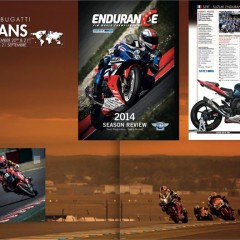 The latest 2014 Endurance Season Review book by renowned French photographer David Reygondeau is now on sale.
The latest 2014 Endurance Season Review book by renowned French photographer David Reygondeau is now on sale.
The large-format hard-back 176-page publication is packed with all the best imagery from this year’s series along with information and facts on all the major teams and riders, including 13-time World Champions Suzuki Endurance Racing Team and World Superstock Champions Junior Team LMS.
Reygondeau, who also shoots all the stunning Endurance images for Team Suzuki’s www.suzuki-racing.com has teamed-up with journalist Valerie Moreno; who provides all the words and information for what is again promised to be a must-have reference publication to have in the library.
It is priced at 45 Euros, plus postage/ shipping costs to various countries, and available now direct from David Reygondeau:david@reygondeau.com
SUZUKI GB ANNOUNCES PARTNERSHIP WITH HALSALL RACING FOR 2015
|
Having agreed terms just last week, Suzuki is delighted to confirm that it will entrust the company’s BSB effort going forwards to Halsall Racing, competing on the GSX-R1000 with a two-rider line-up next season.
Suzuki GB General Manager, Paul de Lusignan, commented, “We are very pleased to agree terms with Halsall Racing for next season. With the obvious enthusiasm and professionalism of team owner Martin Halsall combined with the unrivaled experience of Jack Valentine as Team Manager, we believe we have a strong foundation to build on for next season and beyond.”
Having already taken delivery of 2015 GSX-R1000s, Halsall Racing will commence development with the assistance of Suzuki Motor Corporation, with the first test planned in the new year.
Team owner, Martin Halsall added, “We entered into BSB with clear objectives. We always intended to be here long-term, but our ultimate goal was to represent a manufacturer at the highest level. While our agreement with Suzuki meets that objective, this is really the beginning of a new future for us as a team. I would like to thank Suzuki for the faith they have put into everyone at Halsall Racing and look forward to the season ahead.”
Team Manager Jack Valentine brings not only a wealth of racing experience, but particular experience of Suzuki, having managed both World and British Superbike teams for the brand.
“It’s fair to say that this deal is like coming home for me”, commented Valentine.
Suzuki’s Paul de Lusignan added, “While we’re excited for the future with Halsall Racing, I would also like to take this opportunity to thank Philip and Hector Neill at TAS for their superb support over the last 14 years, and wish them the very best for the future.” |

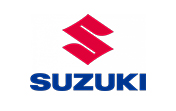
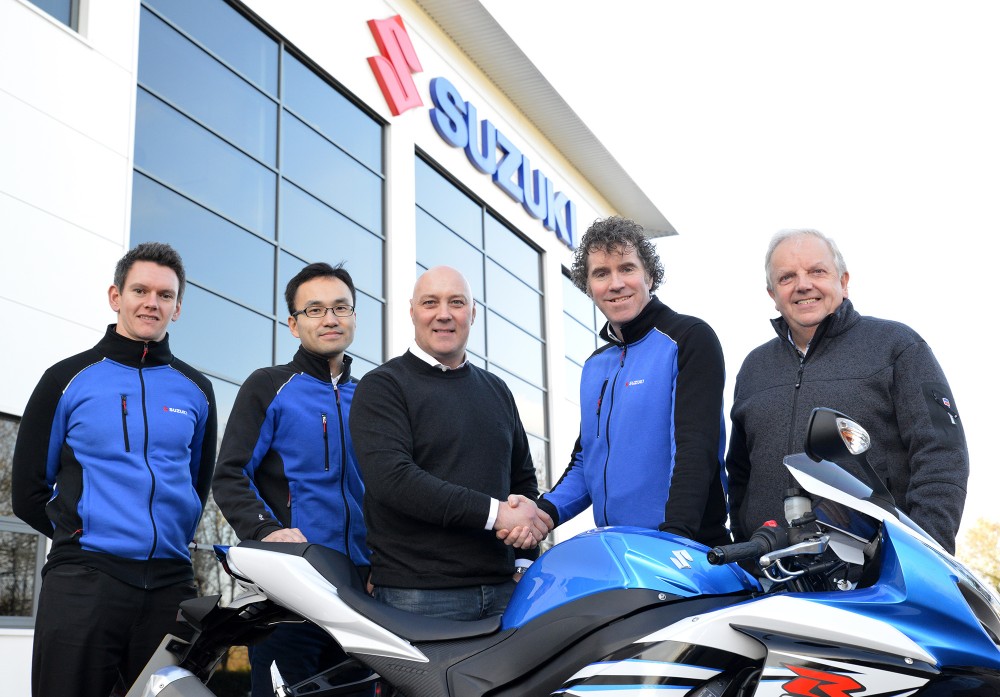 Suzuki GB has today announced its partnership with Halsall Racing for the 2015 MCE British Superbike (BSB) season.
Suzuki GB has today announced its partnership with Halsall Racing for the 2015 MCE British Superbike (BSB) season.